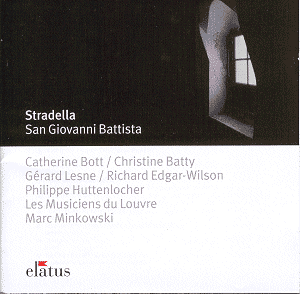Alessandro Stradella had the sort of novelettish
life that makes it difficult to imagine the music living up to.
Luckily, as this welcome reissue proves, the music most definitely
does live up to the life. A slightly older contemporary of Corelli,
Stradella numbered Queen Christina of Sweden amongst his patrons
and the Colonna and the Pamphili families were included amongst
his Roman patrons. His amorous adventures led to his murder in
Genoa at the age of 37. His notorious life became the subject
of an opera by Flotow, as well as many poems, plays and songs.
During his lifetime he was known mainly as a theatrical composer.
Though nowadays his oratorios have been his most prominent works,
his theatrical instincts mean that his treatment of the story
of St. John the Baptist is certainly dramatic.
For a start, he and his librettist (Girardo Ansaldi,
a Sicilian priest) dispense with a narrator. The story is related
in a series of dramatic interchanges between the principal characters;
exchanges between Herod and St. John the Baptist, between Herod’s
wife and his daughter and it ends with a fine duet between Herod
and his daughter.
This oratorio is one of the earliest known instances
of the composer specifying a division between concertino and concerto
grosso textures. It is possible that Corelli may have been one
of the violinists at the work’s first performance in 1657, so
giving us a trail that leads through Corelli on to innumerable
descendants.
The work is in two parts. After an opening Sinfonia,
played in a lively and vigorous manner by Les Musiciens du Louvre,
part 1 opens with a pastoral scene where St. John is preparing
to go to Herod’s court, bidding farewell to the countryside. This
is a potently flexible combination of recitative, short arias
and choruses. If Gérard Lesne’s tone as San Giovanni Battista
is not quite ideal in the more vigorous passages, his opening
aria is sung with a wonderfully seductive tone.
Scene 2 consists of the celebrations for Herod’s
birthday. Catherine Bott as Eriodiade la Figlia (known to us as
Salome) has two substantial arias as she entertains Erode. Philippe
Huttenlocher as Erode (Herod) has a tendency to be unfocused but
he makes up for this by the wonderfully dramatic manner in which
he sings the part. The scene concludes with an ensemble which
leads into scene 3 when San Giovanni Battista interrupts the proceedings,
commands that Erode gives up his brother’s wife and is promptly
thrown into prison for his pains. The drama progresses via a bravura
aria for Erode, sung in a fine dramatic manner by Huttenlocher
(even if he is a little untidy at times) and an ensemble (Stradella
describes it as a madrigal) which is repeatedly interrupted by
Battista. The scene concludes with a duet for Erode and Erodiade
la Figlia.
Part 2 contains the familiar events which lead
up to beheading with the main action being carried by Stradella’s
flexible and dramatic recitative. In the small part of Erodiade,
la Madre, Christine Batty eggs on Catherine Bott in a dramatic
fashion, but Batty’s voice is apt to sound too unfocused. Catherine
Bott’s song of triumph ‘Su coronatemi’ is a lively triple time
dance, to which Bott and Les Musiciens du Louvre give full value.
This leads into a duet for Bott and Huttenlocher, contrasting
their emotions and underlining the incomprehension which exists
between them. Stradella underlines this element by ending the
oratorio in the dominant and on a question. In the small role
of the counsellor, Richard Edgar-Wilson has an unfortunate tendency
to squeeze each individual note, spoiling the sense of line in
the arias.
This recording was first issued in 1992 by Erato
and it merits a warm welcome on the Elatus label. Mark Minkowski
assembled a fine cast who give the oratorio full value. Catherine
Bott is riveting in the key character of Erodiade la Figlia, a
role with a very wide tessitura. If at times her plangent, vibrato-less
tone sounds a shade under the note, this is a small price to pay
for such a bravura performance. The excellent booklet has one
curious lacuna; though the libretto is given in translation (English,
French and German) it is not given in the original Italian.
This is the sort of involving performance that
makes one long to hear more of the composer’s work.
Robert Hugill
